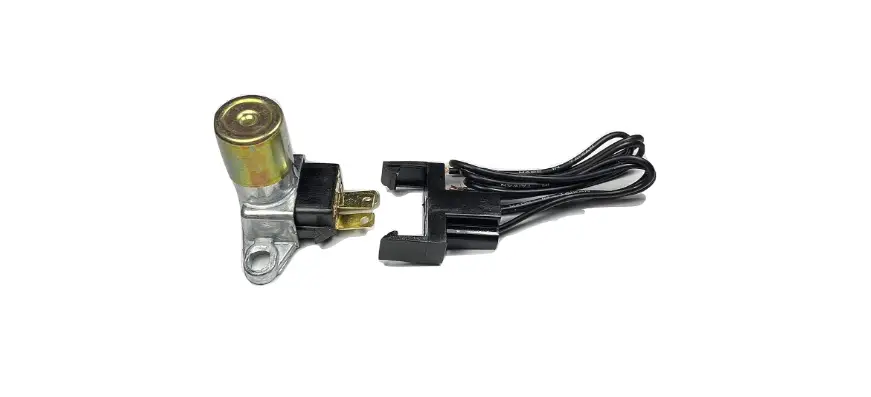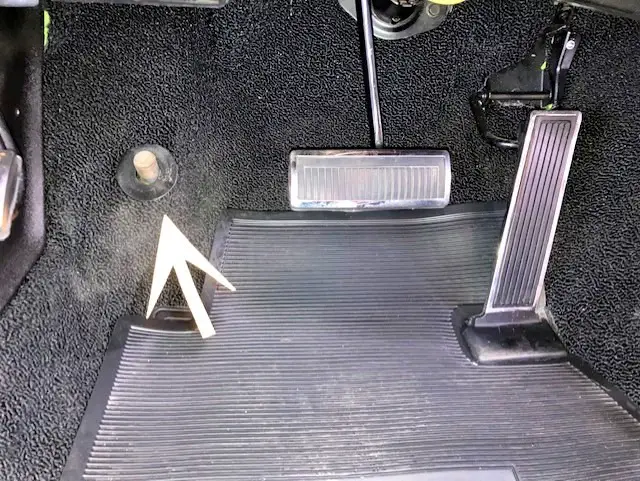A floor-mounted headlight switch, used in older cars, let drivers toggle headlights with a foot pedal. It was replaced by steering column switches for better convenience and safety. Today, it’s mostly found in vintage cars.
The automotive world is full of innovations that have evolved over time, with many features being redesigned or replaced with more modern alternatives. One such feature that has largely disappeared in modern vehicles is the headlight switch on the floor. For drivers of a certain age, the floor-mounted headlight dimmer switch was a familiar and functional part of the driving experience.
This post will dive into the history of this feature, how it worked, why it was phased out, and the nostalgic appeal it still holds for classic car enthusiasts.

Contents
What is a Floor-Mounted Headlight Switch?
A floor-mounted headlight switch, also known as a dimmer switch, was a feature in many cars built before the 1980s. This switch, typically located near the left footrest area of the driver’s side floor, allowed the driver to toggle between the low and high beams of the headlights with a tap of the foot. Drivers could easily switch between the two settings without taking their hands off the steering wheel or their eyes off the road.
How It Worked:
- Activation: Pressing the foot switch would switch the headlights from low beams to high beams and vice versa. This was particularly useful for drivers on rural roads or poorly lit highways where they needed to control their headlights frequently.
- Positioning: Located near the clutch (in manual cars) or next to the brake pedal, the switch was ergonomically placed so that the driver could tap it with their foot without much effort or distraction.
History and Popularity of the Floor-Mounted Headlight Switch
The floor-mounted headlight switch became popular in cars from the 1930s through the 1970s. This feature was standard across many American-made vehicles and trucks from automakers like Ford, Chevrolet, Chrysler, and others. Its design was practical for an era when simplicity and mechanical durability were highly valued.
The origins of the floor-mounted switch can be traced back to the early days of automotive headlight systems. During the first half of the 20th century, cars were much simpler in design, with most controls being manually operated. The floor-mounted headlight switch was seen as an intuitive and durable solution for toggling between high and low beams, especially before advancements in steering column-mounted switches and electrical systems.
Why Was It So Popular?
- Ease of Use: Drivers could easily switch between low and high beams without moving their hands or reaching for a lever.
- Durability: The mechanical nature of the switch made it long-lasting and resistant to wear and tear.
- Standardization: Many vehicles were built with this configuration, making it the go-to design for decades.
Transition to Steering Column-Mounted Switches
By the late 1970s and early 1980s, automotive technology had begun to shift. Automakers were focused on improving safety, convenience, and the aesthetic appeal of vehicle interiors. As a result, the steering column-mounted headlight switch became the standard, and floor-mounted headlight switches started to disappear.
Reasons for the Shift:
- Safety and Ergonomics: Moving the headlight switch to the steering column improved overall safety by reducing driver distractions. With the switch located on the steering wheel stalk, drivers no longer needed to divert attention or foot movement to toggle the lights.
- Consolidation of Controls: Car manufacturers started consolidating multiple controls, such as windshield wipers, turn signals, and headlights, onto the steering column for easier accessibility.
- Technological Advancements: With the rise of electronic components and more advanced electrical systems, the design of car interiors became more streamlined. Mechanical floor switches were seen as outdated compared to the newer, sleeker controls integrated into the steering wheel and dashboard.
- Cost Efficiency: Steering column-mounted switches became easier to install and more cost-effective as automotive designs evolved, with manufacturers seeking to reduce the number of parts and simplify assembly lines.
The Nostalgic Appeal of Floor-Mounted Headlight Switches
Although they have been replaced by more modern designs, the nostalgia for floor-mounted headlight switches remains strong, particularly among classic car enthusiasts. For many drivers, the simple, mechanical feel of pressing the floor switch evokes memories of an earlier era of driving. Classic car restorers and collectors often seek out cars with the original floor-mounted switches as a mark of authenticity and charm.
Why Do Some People Prefer Them?
- Simplicity: The straightforward, no-frills nature of the floor switch is part of its appeal. It doesn’t rely on complex electronics, reducing the risk of malfunction.
- Vintage Aesthetic: For collectors and fans of classic cars, having a floor-mounted headlight switch adds to the vintage authenticity of the vehicle. It’s a feature that represents an era of automotive history.
- Durability: Because of its mechanical nature, a floor-mounted switch is less prone to the electrical issues that modern switches can experience.
How to Maintain a Floor-Mounted Headlight Switch
If you own a classic car with a floor-mounted headlight switch, maintenance and proper care are essential for keeping it in working condition. These switches are generally durable but, like all mechanical components, they can wear out over time.
Here are some tips for maintaining or restoring your floor-mounted headlight switch:
1. Regular Inspection
Periodically check the switch for signs of wear or corrosion. Since it’s located near the floor, it’s susceptible to dirt, moisture, and debris, especially in older cars.
2. Cleaning the Switch
Over time, grime can build up around the switch. Use a compressed air duster to clear out any dust or dirt, and if needed, clean the switch contacts with electrical cleaner to ensure smooth operation.
3. Replacing the Switch
If the switch fails, finding a replacement can be challenging, but not impossible. Many classic car part suppliers offer reproduction switches, or you can search online for used or new old stock (NOS) parts.
4. Upgrading While Retaining the Original Look
For those restoring a classic car but wanting modern functionality, some enthusiasts choose to install a steering column switch while keeping the original floor-mounted switch in place for aesthetic purposes.

Frequently Asked Questions
Here are some FAQs about headlight switch –
1. Why did they stop using floor-mounted headlight switches?
Floor-mounted headlight switches were phased out due to advancements in car design and a focus on improving driver convenience and safety. Moving the headlight controls to the steering column allowed for easier access and reduced the need for the driver to shift foot position while driving.
2. Can I still find replacement parts for floor-mounted headlight switches?
Yes, replacement parts for floor-mounted headlight switches can still be found, especially for popular classic car models. Many specialty automotive parts retailers and online marketplaces offer new, used, or reproduction switches for vintage vehicles.
3. Are floor-mounted headlight switches safe by today’s standards?
While functional and durable, floor-mounted headlight switches are less ergonomic and convenient compared to modern steering column-mounted controls. They are safe when used properly but are generally seen as outdated by today’s automotive standards, which prioritize driver convenience and safety.
4. Can I install a floor-mounted headlight switch in a modern car?
Technically, it is possible, but it would require custom work. Modern cars are designed with integrated electrical systems, and retrofitting a floor-mounted headlight switch would involve significant modification, making it impractical for most drivers.
5. Which classic cars had floor-mounted headlight switches?
Many classic American cars, such as Ford Mustangs, Chevrolet Impalas, and Dodge Chargers from the 1950s to the 1970s, featured floor-mounted headlight switches. Trucks and other utility vehicles also commonly used this design.
Conclusion
The floor-mounted headlight switch may be a thing of the past in modern vehicles, but it remains a beloved feature in the world of classic cars. This simple yet functional design played an important role in early automotive technology, providing drivers with an easy way to control their headlights while keeping their hands on the wheel. Though it has largely been replaced by steering column-mounted switches, the nostalgia and charm of the floor-mounted switch endure for vintage car enthusiasts. For those lucky enough to own a vehicle with this feature, it’s a reminder of a simpler time in automotive history.
Whether you’re restoring a classic car or just curious about automotive innovations of the past, the floor-mounted headlight switch is an interesting piece of automotive history that still sparks fascination today.